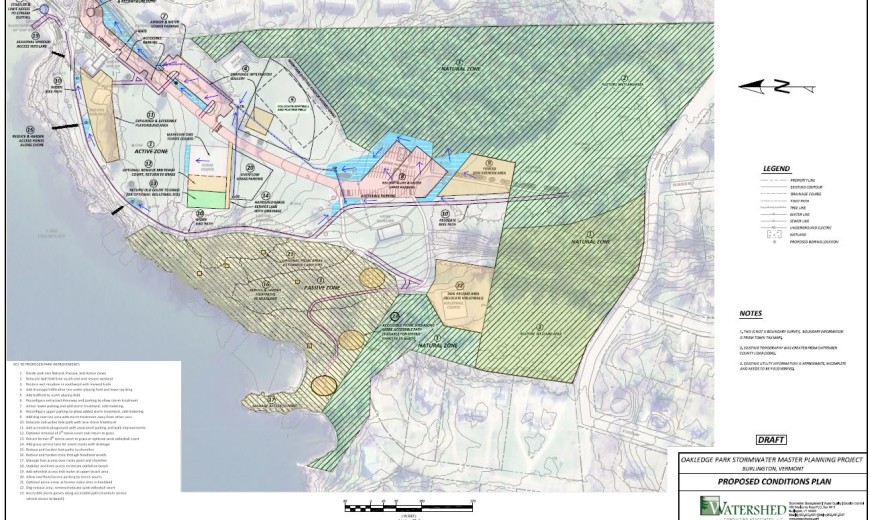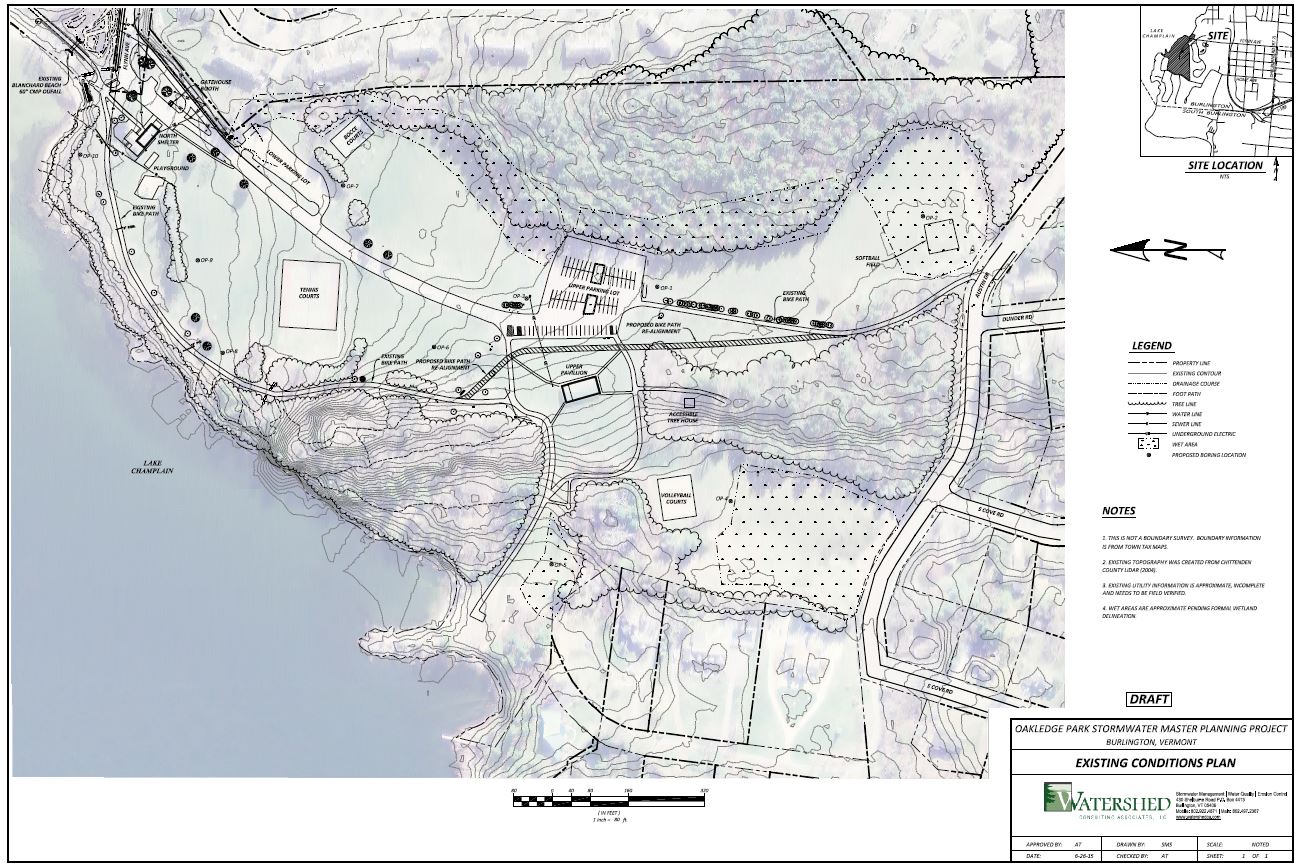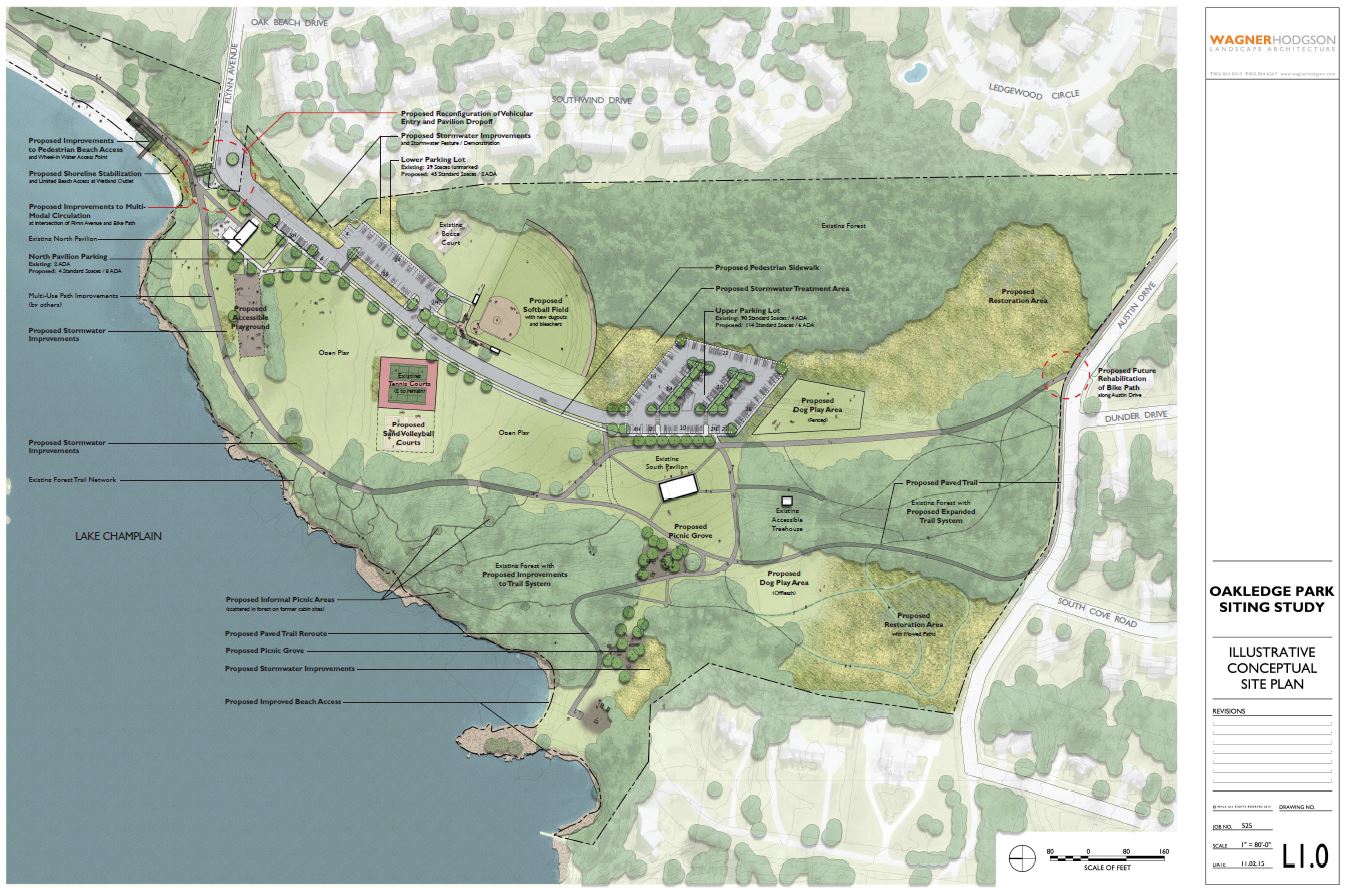Oakledge Park Siting Study

Here’s a recap of the Parks Commission meeting on November 3, 2015 in which we discussed the Oakledge Park Siting Study:
OAKLEDGE SITING STUDY HIGHLIGHTS
Under the direction of the Burlington Parks, Recreation & Waterfront Master Plan, BPRW has concluded a thorough technical ecological analysis of Oakledge Park. The siting study, conducted by a team of local environmental scientists, stormwater experts, and landscape architects was undertaken to better understand the ecology of the park and its critical role in protecting lake health. The goal of the effort is to outline a more resilient balance between ecological constraints and recreation demand, both active and passive, including long-term ideas for ecological restoration, stormwater management, and environmental health. The concepts include consideration of both the strategic preservation of existing amenities and the development of future amenities in the most suitable portions of the park. BPRW will present the conclusions and recommendations from the Oakledge Park Siting Study at the Parks Commission meeting on November 3, 2015 at 5:30pm at the DPW/BPRW Building, 645 Pine St.
GENERAL TIMELINE
- Late winter, we had great response to RFP from several local firms who were based in the SE and/or have a deep love for Oakledge Park
- We chose an exceptional strong proposal led by Watershed Consultants (Andres Torizzo) and Wagner/Hodgson (Hannah Loope, Jeff Hodgson) with support from Lakeside Environmental
- Watershed knows Oakledge and the upstream drainage system that feeds into it. They had previously worked with DPW on the silt spinner and forest wetland restoration at the end of Flynn Ave and near Blanchard Beach
- Extensive soil analysis that included 10 borings to bedrock
-
- Softball field – bedrock at 2.5’ – clay with some sand
- revealed a surprising area of subsurface sandy soil that can be utilized for infiltration and is better suited to facility development
- Vegetation Inventory/Analysis
-
- Survey of larger trees
- Tina Heath from Wetlands Division of DEC
- Wetland areas are likely Class II and any activity within them or the buffer will require a permit
- Bob Pop from Fish & Wildlife walked site focused on rare, threatened, endangered species
- There are four rare/endangered plants in the park
- White tinged sedge, teel lovegrass, narrow leaved blue eyed grass, veiny leave meadow rue
- There are four rare/endangered plants in the park
- Cultural resources were inventoried – made focal points in the natural area/bluffs near Cove Beach
- Input from Lake Champlain Land Trust – Jeff O’Donnell
-
- LCLT was very excited about the ecological/stormwater focus of the siting study
- Had our own field naturalist, Alicia Daniel, review it and she suggested some alternatives for restoring the wetlands. In general, she is very supportive of the ecological bent of the study

TALKING POINTS FROM INTERNAL MEETING
- Built on recommendations from Master Plan “[Oakledge Siting Study] is the first individual park study advanced as a result of the strategies developed in this master plan. It serves as a model for how other parks will be considered in the future.”“Gain better understanding of stormwater & watershed opportunities through partnerships – start with Oakledge…”
- Lead focus concerned soil hydrology and soil impacts, soil structure and bedrock
- Layered cultural context – existing uses, community conversations
- Despite size, there is not available active rec space for every desired use
- There is a finite amount of suitable space for active recreation
- Long assumed that there were ecology restraints
- 2 class 2 wetlands that were being programmed that need to be restored
- Introducing engineered methods to process storm water
- Increasing parks capacity to capture and filter storm water
- Proposing 2 different types of dog recreation
- Smaller fenced in area
- Permissive off leash area west of the bike path
- Formalize existing use
- Expectation from dog users to do their part on picking up waste and prevent it from running into lake
- Community enforcement
- Goal is to relocate softball field out of the class 2 wetland and into a multi-use field facility where it is more suitable at the center of the park
- Softball field is not up to standard and is unplayable in moderate rain
- At the youth level, this field can accommodate all levels of use
- Science not sentiment
- Invitation to the public and user groups to weigh in on how the multi-use field is designed and constructed
- We resisted temptation to engineer the groundwater issues away, and instead learn our lessons from decades of maintaining facilities like the existing softball field.
- Use piece of accessible playground
- $100 investment
- Working group will invest an additional $200-300K
- Parking efficiency increase
- Upper parking Lot
-
-
- from 90 to 114 standard spaces (over 25% increase)
- ADA spaces increase from 4 to 6 (50% increase)
- Lower parking lot
- Gets paved (reduces erosion and makes parking lot more efficient)
- From 39 to 45 standard spaces (15% increase)
- 2 new ADA spaces
-
Lower parking lot, which gets paved, goes from 39 to 45 standard spaces and 2 new ADA spaces.
- Provide more accessibility to volleyball courts
- First priority is designing (winter 2016-17) and constructing the universal playground

Download the PDF of images to view the details: 20151103 Oakledge Siting Study 3 Plans SM
